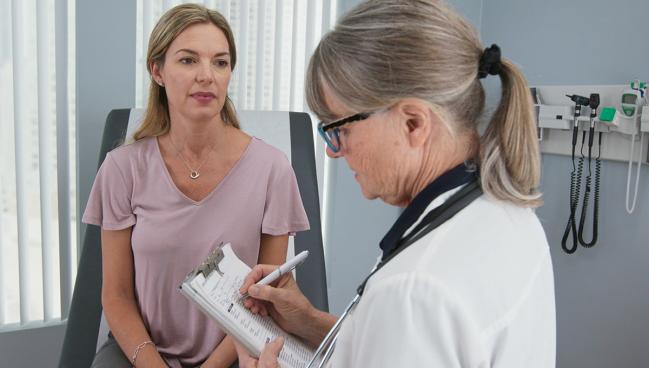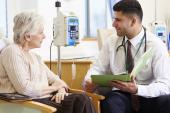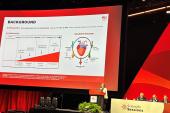Years After Radiation Therapy, Echo Parameters Worse in Breast Cancer Patients
Even modern cancer treatments appear risky for the heart, especially if the radiation dose to the LAD is high.

Women with breast cancer who undergo contemporary radiation therapy see little change to left ventricular function in the first 5 years after treatment, according to observational data. At the same time, though, researchers picked up on “modest” worsening of diastolic function and measures of circumferential and longitudinal strain.
The effect on cardiac function was particularly strong when high radiation doses reached the left anterior descending (LAD) artery, they reported recently in JACC: CardioOncology.
This isn’t the first study to draw a link between cancer treatment and cardiac damage, and professional societies across cardiology have taken note of the risks in their guidance for clinicians: from the Society for Cardiovascular Angiography and Intervention to the American Heart Association, the European Society of Cardiology and, most recently, the Heart Failure Society of America.
What these data offer, lead author Eva Berlin, MD (University of Pennsylvania, Philadelphia), told TCTMD, is a fresh perspective reflecting both modern radiation therapy and modern systemic therapy for cancer. “That’s really important, because the way it’s going to affect the heart is going to be different than it was 20 years ago,” she said, also highlighting the study’s large sample size and yearslong follow-up.
For the researchers, it was surprising to see changes, albeit small, in measures of strain and diastolic function but little shift in LVEF, Berlin noted. “This fits with this heart failure with preserved ejection fraction [HFpEF] phenotype, and this was not something that we expected to see, but we saw this in this dose-dependent way with increasing radiation dose to the heart.”
The consequences will become clearer with time, Berlin explained. “We saw very minimal changes in the first 3 years after radiation. But then we saw these incremental changes as time went on, specifically for patients who are receiving [a higher] dose.”
This makes the case for monitoring patients who receive radiation for breast cancer and keeping an eye out for early signs of HFpEF in the years that follow, she specified. Thanks to concerns about chemotherapy’s effects on the heart, “a large proportion of my patients are getting an up-front echo before they start any cancer treatment to have a baseline, and then they’re getting routinely tested after starting chemotherapy.”
If possible, said Berlin, patients also should be referred to a cardio-oncologist who has the dual expertise to address these needs as well as traditional risk factors.
The LAD Is Key
For their analysis, Berlin and colleagues turned to the longitudinal, prospective Cardiotoxicity of Cancer Therapy cohort study of women with breast cancer undergoing treatment within the University of Pennsylvania Health System. They identified 303 female patients (median age 52 years; 33.3% African American) who received definitive adjuvant external-beam radiation therapy to the breast or chest wall between 2010 and 2019, and who had a baseline echocardiogram done within 3 months before the start of radiation therapy and at least one follow-up echo.
The targets of radiation therapy were balanced, with 51.5% of patients treated to the left breast/chest wall, 45.9% to the right breast/chest wall, and 2.6% bilaterally. Within the population, CV risk factors were common: 33% had hypertension, 22.1% hyperlipidemia, 9.9% diabetes, and 36.0% a current or former smoking history.
The median mean heart dose was 1.19 Gy overall but around threefold higher for the left/bilateral group than for the right group (2.30 vs 0.76 Gy). The difference by treatment site was most pronounced when it came to the median maximum dose to the LAD, which was 8.91 Gy on average but diverged to 39.78 Gy with left/bilateral radiation and 0.45 Gy with right-side radiation.
Follow-up lasted for a median of 5.1 years. LVEF increased modestly from baseline to 5 years (51.2% vs 54.3%; P < 0.001), and there also were slight improvements in measures of ventricular-arterial coupling and RV fractional area change. However, sensitive measures of function, including circumferential strain (-23.7% vs -21.0%; P = 0.003), longitudinal strain, and diastolic function, all worsened.
“Among women who underwent radiation therapy specifically for left-sided/bilateral breast cancer, all parameters of cardiac functioned worsened,” the researchers note.
Additionally, for each interquartile range increase in the maximum LAD dose, there was a 1.1% worsening of longitudinal strain and a 2.1% worsening of LVEF. Higher doses also imparted worse diastolic function as measured by E/e′.
“Our findings provide reassurance as to the lack of overt, clinically substantial detrimental changes in LVEF in the intermediate term following radiation therapy for breast cancer, likely secondary to the low heart dose,” the investigators write. That said, the changes in other parameters may provide an early indication that patients are at risk for subsequent heart failure with preserved ejection fraction, they point out.
A unique feature of their study is that contouring—mapping of the heart’s structure prior to radiation therapy—was done not just of the whole heart but also specifically the LAD, said Berlin. By doing this, “we got a lot more granular and saw that the left anterior descending artery was an important structure when it came to these functional changes.” Future research should focus on how this approach to contouring, perhaps guided by artificial intelligence, might provide relevant details to help gauge the risk posed by radiation therapy, she added.
Even now, clinicians should, in high-risk cases, consider calculating the dose to the LAD, advised Berlin. “I think that’s an actionable thing that we can start doing now even though the science is still growing in the area.”
Caitlin E. Cox is News Editor of TCTMD and Associate Director, Editorial Content at the Cardiovascular Research Foundation. She produces the…
Read Full BioSources
Berlin E, Ko K, Ma L, et al. Cardiac effects of modern breast radiation therapy in patients receiving systemic cancer therapy. JACC CardioOncol. 2025;Epub ahead of print.
Disclosures
- This work was supported by funding and support from the National Institutes of Health and the American Heart Association Strategically Focused Research Network Award in Cardio-Oncology as well as the Abramson Cancer Center Pilot Grant.
- Berlin reports no relevant conflicts of interest.





Comments